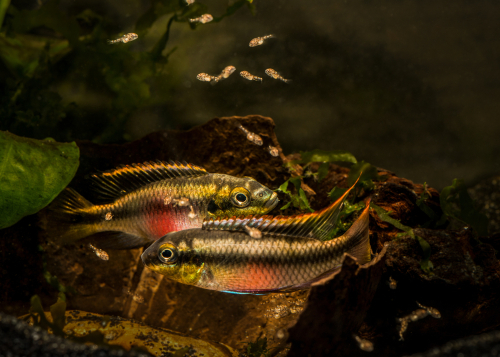Anyone who has put together a community fish tank knows how complicated the process can be. There are so many possible combinations of species that can be placed together, but very few will genuinely get along and be happy in the same space.
Don’t worry, we’ve come up with a list of the best Kribensis tank mates so that you know which the top options are.
Putting the wrong fish in an aquarium together can be a fatal mistake: literally. That’s why this decision is so important. You have to know that your Kribensis Cichlids are not going to come to any harm, and neither are their new friends.
Contents
What You Should Know: Best Kribensis Tank Mates
Some species are incredibly difficult to house and do not like to play with others, but Kribensis Cichlids are actually very friendly and easy-going. Even still, you do need to be aware of quite a few different factors if you’re going to ensure that all of your fish will thrive in a happy and healthy way.
Personality and Temperament
These particular Dwarf Cichlids have a pretty peaceful temperament, but that is not true of every other aquarium fish in the hobby. To make sure your Kribensis aren’t harassed or harmed, you should be looking out for other fish that are non-aggressive and calm.
That doesn’t mean that you always have to choose an inactive and shy species – many fish love to move around without being aggressive. As long as they’re not likely to harass or cause any harm to your Cichlids, then you should be okay.
Tank Conditions and Water Parameters
Placing more than one species in the same tank can be a risk because each will have its own slightly different needs. That’s why you have to make sure that everyone will be able to thrive in the same kind of water, and with the same sort of tank setup.
Kribensis Cichlids like their water to be:
- Type: Freshwater
- Hardness: 5 – 20 dGH
- Temperature: 75 to 80 °F
- pH: 5.6 to 7.0
- Tank size: 20-gallon
Competition
Choosing compatible fish is not just about avoiding fights. You also need to make sure that each individual is able to have access to all the space and resources that allow them to be relaxed, comfortable, and healthy.
You want to ensure that your Kribensis are not going to be stressed and overcrowded, so you need enough room for them to have their own territory. It can also help to choose fish that spend more time near the surface or middle of the tank because Kribensis Cichlids usually hang out in the lower sections.
Species Size
Another factor that you should always consider is the size of your fish. Larger, more aggressive species are more likely to cause harm to a Kribensis– either intentionally or by accident.
On the other hand, significantly smaller fish can be a little vulnerable. Fortunately, Kribensis Cichlids are not very boisterous, so they are pretty safe around most smaller species.
It’s usually a good rule of thumb to aim for fish that are a similar size where possible, and Kribensis Cichlids usually range from around 3 to 4 inches when fully grown.
The Best Kribensis Tank Mates
So, with all of that in mind, which fish make the best tank mates for your Kribensis Cichlids? Let’s take a look at 12 of the best options that you could choose from so that you can start putting together the perfect, peaceful community.
You might also like:
- Electric Blue Jack Dempsey Tank Mates
- Fahaka Puffer Tank Mates
- Bumblebee Goby Tank Mates
- South American Cichlids Tank Mates
1. Dwarf Cichlid

- Scientific Name: Cichlidae (family)
- Care Level: Easy to Moderate
- Alternative Tank Mates: Tetra, Hatchetfish, Rasboras
- Required Water Temperature: 70 to 85 °F
- Minimum Tank: 10 to 20-gallon
- Size Range: 3 to 4.5 inches
If you’re looking for the most compatible species out there, then it doesn’t get better than other Dwarf Cichlids. Because they will be so similar to your Kribensis, their needs will match perfectly, and many are peaceful and friendly as well. A few stunning Dwarf Cichlids to consider include the German Blue Ram, the Golden Dwarf, and the Umbrella.
Pros
- Variety of colors and appearances
- Very similar needs
Cons
- Certain species can compete with each other
2. Siamese Algae Eater
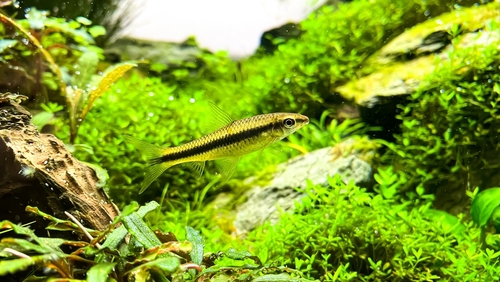
- Scientific Name: Crossocheilus oblongus
- Care Level: Easy
- Alternative Tank Mates: Guppies, Tetras, Danios
- Required Water Temperature: 75 to 79 °F
- Minimum Tank: 25-gallon
- Size Range: 5.5 to 6.5 inches
True to their unique name, these fish are not only peaceful and friendly with their tank mates but they also help to clean up the environment as well. They like to eat algae, and they are considered one of the most efficient tank cleaners in the aquarium world.
Pros
- Peaceful and social
- Efficient tank cleaners
Cons
- Need a reasonable amount of room to move
3. Swordtail
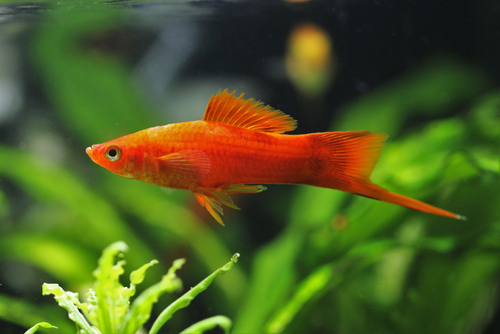
- Scientific Name: Xiphophorus helleri
- Care Level: Easy
- Alternative Tank Mates: Platies, Mollies, Angelfish
- Required Water Temperature: 72 to 79 °F
- Minimum Tank: 20-gallon
- Size Range: 3 to 4 inches
Swordtails are much beloved for their distinct appearance and sociable personalities. One of the major benefits of housing Swordtails with your Cichlids is that they tend to prefer the top or mid-level of the tank, which means they won’t invade each others’ space very often.
Pros
- Easy-going and low maintenance
- Top and mid-dwellers
Cons
- Males can be territorial
4. Molly
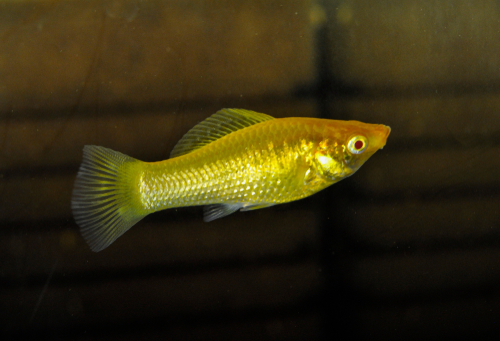
- Scientific Name: Poeciliidae (family)
- Care Level: Easy
- Alternative Tank Mates: Corys, Danios, Tetras
- Required Water Temperature: 75 to 80 °F
- Minimum Tank: 10-gallon
- Size Range: 4 to 5 inches
There are a lot of different types of Molly Fish to choose between, including Common Mollies, Sailfin Mollies, Black Mollies, and Golden Mollies. They come in a variety of colors and looks, but all of these types are easy to look after and make for peaceful companions for your Dwarf Cichlids.
Pros
- Variety of types
- Peaceful and easy-going
Cons
- Can become stressed in the wrong environment
5. Congo Tetra
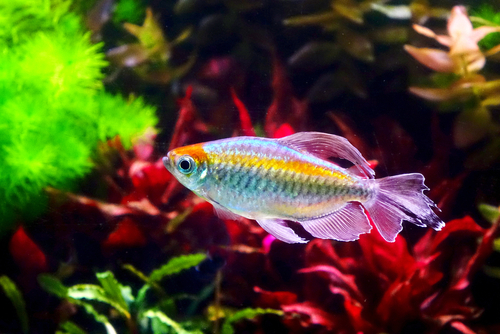
- Scientific Name: Phenacogrammus interruptus
- Care Level: Easy
- Alternative Tank Mates: Rainbowfish, Corys, Swordtails
- Required Water Temperature: 72 to 82 °F
- Minimum Tank: 30-gallon
- Size Range: 3 to 3.5 inches
There are a huge number of different kinds of Tetra to choose from, but the Congo Tetra is one of the best for living alongside your Kribs. They are eye-catching and vibrant, and they are slightly larger than most other Tetras, which means they are less likely to be nervous or intimidated.
Pros
- Attractive colors
- Easy to care for
Cons
- Need a larger tank than some types
6. Corydoras Catfish

- Scientific Name: Corydoras (genus)
- Care Level: Easy
- Alternative Tank Mates: Tetras, Rasboras, Swordtails
- Required Water Temperature: 72 to 82 °F
- Minimum Tank: 10-gallon
- Size Range: 1 to 4 inches
You might notice that the Corydoras Catfish (or Cory) appears as an alternative tank mate for many of the species on our list. This is because they can easily fit into a variety of different communities. They are non-aggressive and friendly, so they are safe around even much smaller fish.
Pros
- Friendly and non-aggressive
- Easy to care for
Cons
- Sensitive to nitrates and ammonia
7. Cherry Barb
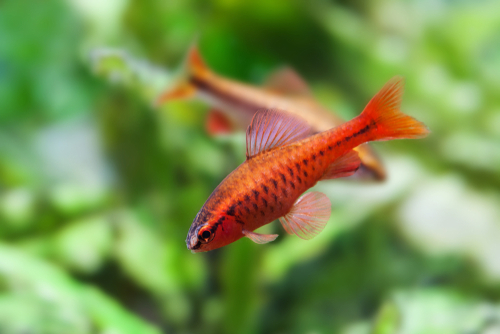
- Scientific Name: Puntius titteya
- Care Level: Easy
- Alternative Tank Mates: Gouramis, Loaches, Tetras
- Required Water Temperature: 73 to 81 °F
- Minimum Tank: 20-gallon
- Size Range: 1.5 to 2 inches
Cherry Barbs might be bright and vibrant in color, but they actually have quite timid and skittish personalities. While they might spend time in similar areas of the tank to your Kribensis Cichlids, these peaceful schooling fish keep to themselves, and (unlike some other barbs) they rarely nip.
Pros
- Peaceful and timid
- Bright colors
Cons
- Can become nervous or stressed
8. Dwarf Gourami
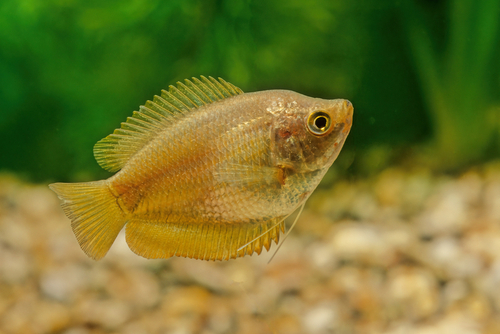
- Scientific Name: Trichogaster lalius
- Care Level: Intermediate
- Alternative Tank Mates: Tetras, Mollies, Rasboras
- Required Water Temperature: 72 to 82 °F
- Minimum Tank: 10-gallon
- Size Range: 3.5 to 4.5 inches
As another Dwarf species, these fish are much closer in size to your Kribensis than other Gouramis can be. They are colorful, varied, and mostly peaceful, but they can fight each other for territory. They also get a little nervous if they don’t have a quiet area to relax in.
Pros
- Attractive appearance
- Good size for Kribensis
Cons
- Can be nervous and territorial
9. Kuhli Loach

- Scientific Name: Pangio kuhlii
- Care Level: Easy
- Alternative Tank Mates: Tetra, Danios, Rasboras
- Required Water Temperature: 75 to 86 °F
- Minimum Tank: 20-gallon
- Size Range: 3 to 4 inches
If you want to include something easy to care for but a little out of the ordinary, Kuhli Loaches are a fantastic and intriguing fish. They are sociable, if a little bit shy, and they have an appearance almost like a patterned eel.
Pros
- Interesting appearance
- Social and easy to care for
Cons
- Nocturnal and usually inactive during the day
10. Rubber Lip Pleco
- Scientific Name: Chaetostoma milesi
- Care Level: Easy
- Alternative Tank Mates: Tetras, Gouramis, Corys
- Required Water Temperature: 72 to 78 °F
- Minimum Tank: 25-gallon
- Size Range: 3 to 6 inches
Quite a few Plecos can get along with Kribensis Cichlids, but the Rubber Lip is certainly one of the most suitable. They are very relaxed and well-known to be practically the least aggressive freshwater fish that you will be able to find. They like to latch onto part of the tank and spend most of their time slowly moving around the aquarium.
Pros
- Very peaceful
- Interesting appearance
Cons
- Slow-moving and relatively inactive
11. Harlequin Rasbora

- Scientific Name: Trigonostigma heteromorpha
- Care Level: Easy
- Alternative Tank Mates: Tetras, Small Barbs, Danios
- Required Water Temperature: 72 to 81 °F
- Minimum Tank: 10-gallon
- Size Range: 1.7 to 2 inches
One of the smallest options on our list, Harlequin Rasboras are lovely to look at and friendly with the other fish in their tank. They come in a variety of colors but are notable for the black triangular marking of their sides. They’re active and fun to watch, and they do best with at least 10 individuals in a group.
Pros
- Entertaining
- Peaceful and friendly
Cons
- Happiest in larger groups
12. Tiger Barb
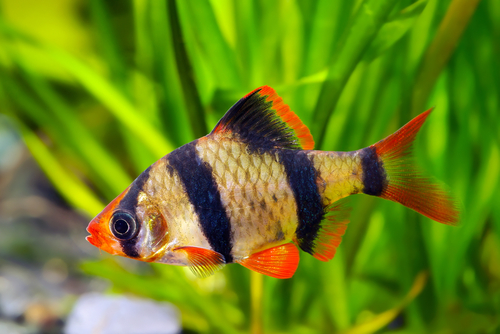
- Scientific Name: Puntius tetrazona
- Care Level: Easy to Moderate
- Alternative Tank Mates: Plecos, Loaches, Tetras
- Required Water Temperature: 72 to 82 °F
- Minimum Tank: 20-gallon
- Size Range: 2.5 to 4 inches
Another excellent Barb option for your Kribensis tank is the Tiger Barb. They are much beloved for the distinctive stripes that give them their name, and they are a little bit more boisterous and full of personality than their Cherry cousins. This does mean that they have a reputation for nipping and chasing, but they rarely cause any harm.
Pros
- Interesting pattern
- Vibrant personality
Cons
- Slightly boisterous and can harass other fish
Summary
So, what kind of fish should you aim to house with your Kribensis Cichlids? Fortunately, these beautiful and peaceful creatures are actually well-known for being very hospitable and getting along with a wide range of different species.
You do, however, need to find fish that like the same conditions, are also reasonably peaceful, and are not going to compete too much for food and space. A few of the most compatible options include other Dwarf Cichlids, Siamese Algae Eaters, Swordtails, and Mollies.

Ian Sterling, founder of Fishlab.com, began his aquarium journey over 30 years ago, driven by a deep fascination for fish and their diverse personalities. His website, Fishlab.com, is dedicated to making fishkeeping accessible and enjoyable, offering beginner-friendly guidance, expert insights, and a community for aquarists to connect and share experiences.


